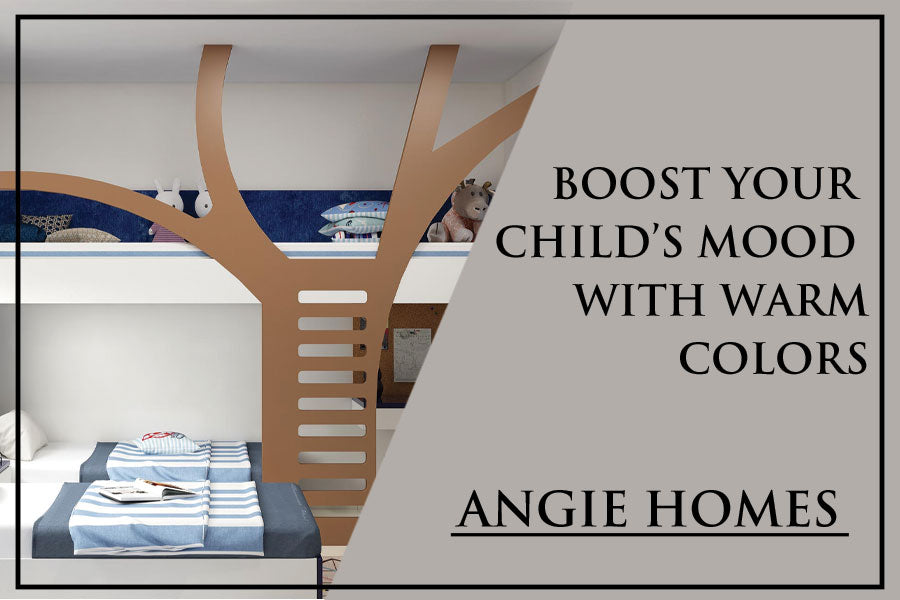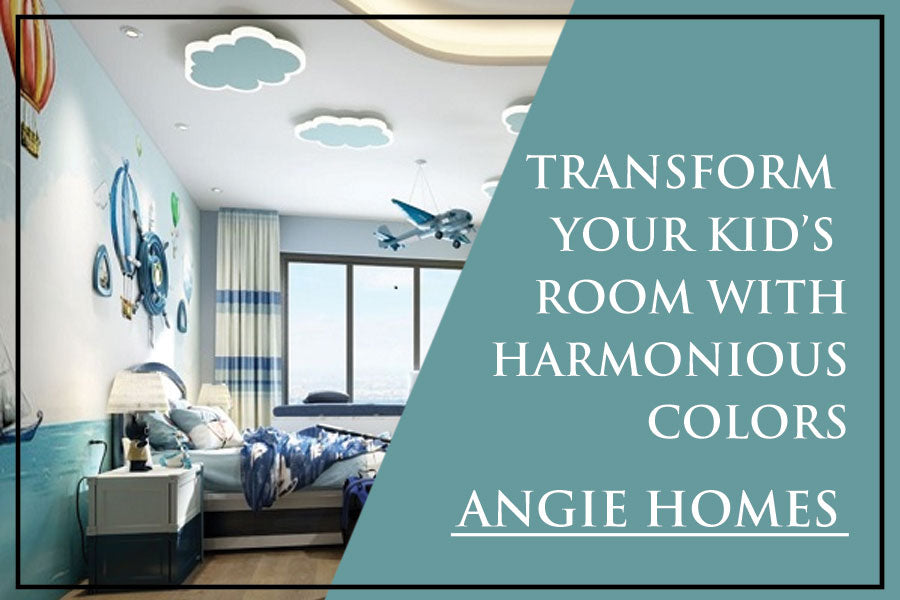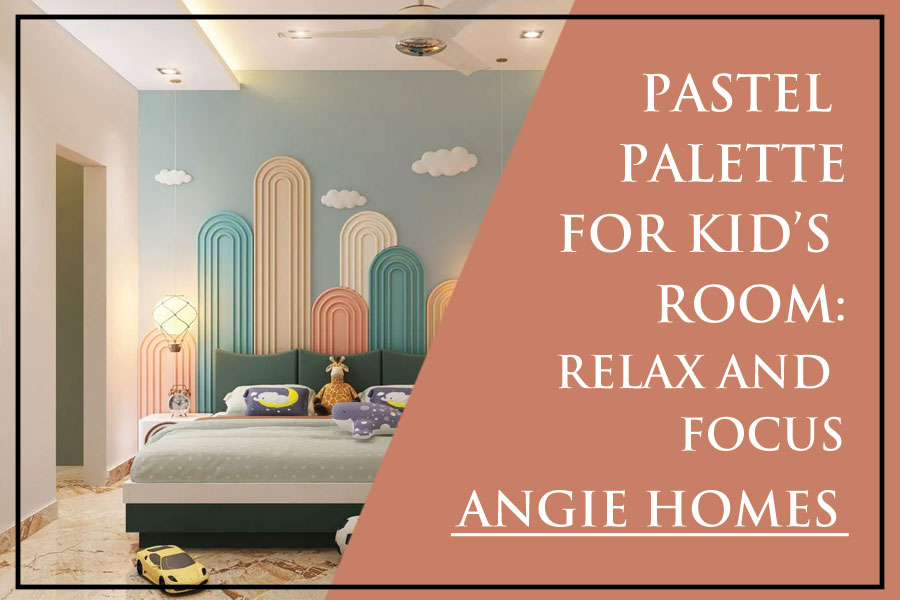Introduction
In the ever-evolving realm of parenting, the desire to create an environment conducive to a child's well-being has become paramount. One often overlooked aspect to shape your kid's mood is the color scheme of their living spaces. The colors surrounding a child can significantly impact their emotions, energy levels, and overall mood. In this comprehensive guide, we delve into the intricate world of colors and how you can shape your kid's mood with the right choices. From warm hues to soothing tones, vibrant contrasts to harmonious blends, and the subtle charm of pastels, we explore the transformative power of colors in your child's bedroom.
Boost Your Child’s Mood With Warm Colors

The use of warm colors to shape your kid's mood in a child's bedroom can have a profound impact on their mood and emotions. Warm colors, such as reds, yellows, and oranges, are known for their stimulating and energetic properties. These colors can evoke feelings of warmth, happiness, and positivity. Understanding the psychology behind warm colors allows parents to strategically incorporate them into their child's room for maximum effect.
Warm colors are associated with various emotions and traits and can shape your kid's mood . For instance, red is often linked to energy, passion, and excitement, while yellow is associated with joy, optimism, and creativity. Orange combines the vitality of red and the brightness of yellow, creating a color that radiates warmth and enthusiasm. By incorporating these hues strategically, parents can shape your kid's mood and create a vibrant and lively atmosphere in the bedroom.
Implementing Warm Colors in Your Kid's Room

When choosing warm colors for your child's room, it's essential to strike a balance. While these colors can bring energy and positivity, too much of them can be overwhelming. Consider using warm colors as accents or in combination with neutral tones to create a visually appealing and balanced space and shape your kid's mood.
For example, painting one accent wall in a warm shade while keeping the remaining walls neutral can add a pop of color without being overpowering. Additionally, incorporating warm-colored furnishings, such as bedding, rugs, or wall art, can infuse the room with the desired energy and shape your kid's mood without dominating the entire space. By carefully selecting and placing warm colors, parents can enhance their child's mood and create a bedroom that is both stimulating and comforting.
This detailed exploration of warm colors is just the beginning of our journey into the world to shape your kid's mood through bedroom colors. The subsequent sections will delve into soothing colors, the perfect balance of natural palettes and vibrant accents, the harmony of colors, and the serene influence of pastels. Stay tuned for a comprehensive guide on transforming your kid's room into a haven of positive energy and emotional well-being.
Soothing Colors for Kids’ Room

While warm colors can bring vitality and energy, there's also a crucial need for balance in a child's living space and shape your kid's mood. Introducing soothing colors is essential to create a tranquil and restful environment. Calming colors, such as blues, greens, and soft purples, have a naturally relaxing effect on the mind and body. Understanding the significance of these colors is key to shaping a serene atmosphere in your child's room.
Buy Online with Best Price Mat Blue Kids Double Bed With Head Board
Research suggests that cool colors can help lower heart rates, shape your kid's mood and reduce stress levels. Blue, in particular, is often associated with calmness, serenity, and a sense of security. Green symbolizes nature and growth, fostering a connection to the outdoors and promoting a peaceful ambiance. Soft purples, with their blend of calming blue and stabilizing red, can shape your kid's mood and induce a sense of balance and tranquility.
Best Soothing Colors for a Tranquil Environment

When incorporating soothing colors into your child's room, consider using them as the primary palette for the walls to shape your kid's mood. Soft blues or greens can create a serene backdrop that promotes relaxation and sleep. Additionally, bedding, curtains, and other furnishings in calming hues contribute to the overall tranquil atmosphere.
To enhance the soothing effect, introduce elements inspired by nature. Consider nature-themed wall decals, artwork, or bedding featuring images of trees, clouds, or animals. These elements not only align with calming colors but also create a connection to the natural world, promoting a sense of peace and well-being.
Our exploration of calming colors demonstrates the importance of creating a balanced atmosphere to shape your kid's mood. As we move forward, we'll discover the power of combining neutral tones with vibrant accents, explore the concept of harmony in colors, and unlock the potential of pastel palettes for relaxation and focus. Every color choice plays a role in shape your kid's mood, and by understanding the dynamics, parents can craft a harmonious environment that nurtures emotional well-being.
Natural Palette, Vibrant Accents: Perfect Contrast

1. Balancing Neutral Tones and Bright Accent:
Achieving the right balance between neutral tones and vibrant accents is a sophisticated approach to creating a visually stimulating yet harmonious bedroom environment. Neutral colors, such as whites, grays, and earth tones, provide a versatile foundation that allows vibrant accents to shine and shape your kid's mood. The key lies in understanding how to strike a perfect contrast to capture the child's interest without overwhelming the space.
Neutral tones offer a timeless and calming backdrop for any room. They create a sense of openness and flexibility, allowing for easy adaptation as the child grows. By incorporating neutral colors on walls, flooring, and larger furniture pieces, parents can establish a clean canvas for the introduction of vibrant accents.
2. Creating a Stimulating Environment with Vibrant Accents:
Vibrant accents inject personality and energy into the room and shape your kid's mood. These can be introduced through colorful furniture, wall art, bedding, and accessories. The contrast between neutral and vibrant colors creates a dynamic visual appeal while preventing the room from feeling too monotonous or overly stimulating.
Consider using a bold color, such as red or yellow, for accent furniture or decor items to shape your kid's mood. This adds a playful touch without dominating the entire space. Artwork featuring vibrant colors can also serve as a focal point, sparking creativity and imagination in your child.
Our journey into the world of contrasting natural palettes with vibrant accents has just begun. In the upcoming sections, we will explore the concept of harmony in colors and delve into the calming influence of pastel palettes. Understanding how to balance various elements is crucial to shape your kid's mood positively. Stick with us as we unveil the secrets to transforming your kid's room into a balanced and stimulating haven.
Transform Your Kid’s Room With Harmonious Colors

Harmony in colors involves the artful blending of different hues to create a pleasing and balanced visual experience. In the context to a shape your kid's mood, achieving color harmony is essential for fostering a sense of cohesion and tranquility. Understanding the principles of color harmony, such as complementary, analogous, or monochromatic schemes, allows parents to create a visually appealing and emotionally balanced space.
Complementary colors, situated opposite each other on the color wheel, can create a dynamic and energetic environment. Analogous colors, found next to each other on the wheel, offer a more subtle and harmonious feel. Monochromatic schemes, utilizing variations of a single color, provide a sense of unity and simplicity.
-
Choosing Colors That Work Well Together
When applying the concept of color harmony to your child's room, consider the preferences and personality of your child to shape your kid's mood. Complementary colors can be employed for a vibrant and stimulating atmosphere, suitable for energetic and creative children. Analogous color schemes, with their softer transitions, are ideal for creating a harmonious and calming environment.
For example, a complementary scheme of blue and orange can be achieved by painting one wall in a soft blue hue and incorporating orange accents through decor items or bedding. Conversely, an analogous scheme of greens and blues can be employed for a more tranquil atmosphere, especially suitable for children who thrive in calm and serene settings.
The exploration of harmonious colors demonstrates the intricate yet rewarding process of creating balance and cohesion in your child's bedroom. As we progress, we will unravel the calming influence of pastel palettes, offering a gentle and soothing alternative for relaxation and focus. Each step in this color journey plays a crucial role to shape your kid's mood positively.
Pastel Palette For Kid’s Room: Relax And Focus

Pastel colors, with their soft and muted tones, are renowned for their calming and soothing effectsand to shape your kid's mood. These light hues, often derived from mixing a pure color with white, create a gentle and serene atmosphere. The application of pastel colors in a child's room is particularly beneficial for promoting relaxation and concentration.
Pastel blues and greens, reminiscent of a clear sky or a tranquil meadow, can evoke a sense of calmness and connection to nature and shape your kid's mood. Soft pinks and lavenders, reminiscent of delicate flowers, add a touch of sweetness and warmth to the environment. The calming influence of pastel colors makes them an ideal choice for creating a bedroom space that encourages relaxation and focus.
When integrating pastel colors into your child's room, consider using them as the primary color scheme for the walls. A pastel-colored feature wall can serve as a focal point, promoting a sense of tranquility and shape your kid's mood. Complement this with light-colored furniture and bedding to maintain the overall soft and soothing ambiance.
To enhance the calming effect, incorporate soft textures and natural materials, such as plush rugs, comfortable bedding, and wooden accents. Pastel-colored artwork or decor items can add a touch of whimsy without disrupting the peaceful atmosphere. By carefully curating a pastel palette, parents can create a space that fosters relaxation and concentration and shape your kid's mood, ideal for both play and rest.
Our exploration of pastel palettes illustrates the gentler side of color psychology, offering a harmonious and soothing alternative for your child's room. As we approach the conclusion of this comprehensive guide, we reflect on the journey through warm colors, soothing tones, vibrant contrasts, harmonious blends, and the serene influence of pastels. Every color choice plays a vital role to shape your kid's mood positively. Join us in the concluding section as we wrap up our insights and offer a summary of key takeaways.
Conclusion
In the quest to shape your kid's mood positively, the color palette of their bedroom emerges as a powerful tool. From the vibrant energy of warm colors to the tranquility of soothing tones, the perfect balance of natural and vibrant hues, the harmony in color schemes, and the serene influence of pastels, each choice contributes to the overall emotional landscape of the room.
Understanding the psychology of colors empowers parents to create a space that not only reflects their child's personality but also nurtures their emotional well-being. Striking the right balance between stimulating and calming elements, vibrant accents and neutral foundations, and harmonious color schemes allows for a holistic approach to crafting a bedroom that evolves with your child's needs.
In conclusion, the journey to shape your kid's mood through bedroom colors is a nuanced and rewarding endeavor. By incorporating the insights shared in this guide, parents can create a space that not only appeals to the aesthetic senses but also promotes a positive and nurturing atmosphere for their child's emotional and mental development. May the colors in your child's room be a canvas for joy, creativity, and a sense of security, shaping their mood in the most delightful ways.
Also Read: Kindle Creativity With These Innovative Study Table Designs for Kids
FAQ's
Q. Which color is best for kids' bedroom?
Ans: Selecting the best color for a kid's bedroom to shape your kid's mood depends on various factors, including the child's age, personality, and preferences. However, generally, softer and more muted tones are recommended. Calming colors like light blues, greens, and pastels are popular choices. These colors create a soothing environment, promote relaxation, and contribute to better sleep quality. Avoiding overly vibrant or stimulating colors in large doses is crucial to prevent overstimulation, especially during bedtime. It's also beneficial to involve the child in the color selection process, considering their favorite shades and incorporating them in a way that maintains a harmonious and balanced atmosphere.
Q. Why are colors important in a kids' room?
Ans: Colors play a pivotal role in a child's room as they significantly impact mood, behavior, and overall well-being. Bright and stimulating colors can enhance creativity, energy, and enthusiasm, making them suitable for play areas and shape your kid's mood. On the other hand, calming colors contribute to a peaceful atmosphere, fostering relaxation and better sleep. The right color scheme can positively influence a child's emotional development, creating a space that feels safe, comfortable, and conducive to learning. Additionally, colors can reflect a child's personality and interests, allowing them to connect with their environment on a personal level. Ultimately, the careful selection of colors contributes to a balanced and nurturing environment that supports a child's growth and development.
Q. What are the calming colors for children's bedrooms?
Ans: Calming colors are essential for creating a tranquil and restful atmosphere in children's bedrooms. Some of the best calming colors include soft blues, greens, lavenders, and muted pastels. Blue, in particular, is associated with calmness and serenity, making it an excellent choice for promoting relaxation and reducing stress. Green, reminiscent of nature, has a soothing effect and is often linked to feelings of harmony. Muted pastels, such as light pinks and lavenders, create a gentle and calming ambiance.
It's important to strike a balance between these calming colors and avoid overly vibrant or intense hues that may lead to overstimulation. The goal is to create a serene space that fosters a sense of peace, making bedtime and relaxation more enjoyable for children.
